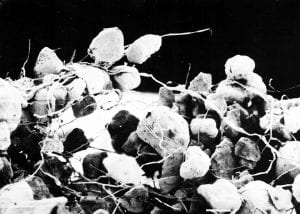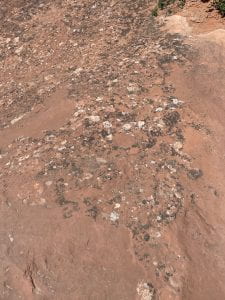(Click on the following link to listen to an audio version of this blog …. Biological soil crusts, rock varnishes and kangaroo rats )
One of the main distinctions between an arid grassland and a desert is the abundance of bare soil in between a desert’s isolated clusters of plants. For centuries it has been recognized that these desert soils were not just random mixes of simple soil separates (sand, silt and clay particles). Instead, this soil was darker than it would be if it were only made up of soil particles. It was also lumpy and in a micro-topographic way, complexly structured with tiny turrets, folds, mounds and crevices. Initial names for these dryland soils often had the prefix “crypto” appended to them implying that they had a mysterious or hidden nature. They were, though, just sitting there out in the open waiting for detailed examination and description.
Research teams of botanists and agronomists finally began to peel away the “crypto” nature of these dry soils in the late 1970’s and showed them to be complex micro-communities dominated by cyanobacteria (“blue-green algae,” one of the oldest photosynthesizing organisms on Earth (see Signs of Winter 9, February 13, 2020, and Signs of Summer 16, September 17, 2020)). These soil surface communities also contained green algae, lichens, fungi, mosses and a variety of other species of bacteria. All of these living organisms acted to stabilize the desert soil and nurture the surrounding plants in entirely unexpected ways. These thin, delicate encrustations, now called “biological soil crusts” (or, “biocrusts”) were, in fact, the living “top soil” of the desert! These patches of “bare” soil, in fact, contained more species than could be found in all of the surrounding desert vegetation!
Cyanobacteria make up to 95% of the biomass of a biocrust. These photosynthetic bacteria grow in long, filamentous strands that are woven around the individual soil particles. They need to keep themselves exposed to sunlight in order to power their photosynthetic metabolisms (so they can’t go very deep into the soil profile!). Cyanobacteria can tolerate extreme desiccation and are able to rapidly re-hydrate when moisture once again becomes available. Dried filaments, when they re-hydrate, swell to ten times their desiccated volume thus storing a large volume of vital soil water. New filaments are slowly added to the fiber systems and, over years and decades and even centuries, the soil particles become tightly woven into a complex bacterial framework. The cyanobacterial filaments also secrete sheathes of mucopolysaccharides which act to further bind the soil separates together. These extracellular mucopolysaccharides persist and continue to cement the soil components together even during period of extreme filament desiccation.
The impact of these filaments and sheaths on the soil is profound. Erosion both by wind and by water is significantly reduced in soils stabilized by these filaments. The potentially destructive impact of raindrops striking exposed soil is also reduced by the hard barrier of the crust, and the dark color of the crust absorbs sunlight and speeds up the thawing of the soil in the Spring.
The complex soil structure generated by these filaments and sheaths forms aeration and water flow channels through the crust. It also generates complex, raised edge depressions on the soil surface that allows surface water to pool up and then seep down slowly into the soil profile rather than simply running off in surface flow. Also, a number of the bacteria in the crust are nitrogen fixers (they remove molecular nitrogen from the air and convert it into chemical forms that can be utilized by plants). For many desert plants, this is the only source of nitrogen available to them!
The crust also serves as a nutrient bed within which the seeds of many plant species germinate. As these plants begin to grow, the crust with all of its spaces and channels also facilitates root growth.
Biological soil crusts once covered all of the dry, exposed soils of Colorado Plateau. Livestock trampling and human activities, though, have greatly reduced the distribution of these crusts. The cyanobacterial filaments and mucopolysaccharide sheaths are very sensitive to compressional damage. A single footprint can destroy all of the underlying soil crust filament infra-structure and leave a scar that takes decades to repair. “Don’t Crush the Crust” is a theme widely advertised on the hiking trails throughout the Plateau’s National Parks.
Rock varnishes are thin, dark or reddish-brown coatings on desert rocks and cliff faces that were once thought to have origins similar to those of biological soil crusts. Recent research, though, has clearly shown that these hair-thin patinas, usually found on very sheltered rocks, are chemical in their origin rather than biological.
Rock varnishes (also called “desert varnishes,” or “rock rusts”) form when silica atoms either in the atmosphere or from the underlying rock itself slowly
accumulate on the rock surface and weather into a stable, dry gel. This process is very slow and may occur over centuries or even millennia. The color of the varnishes often reflect the presence of iron oxides (reddish brown) or manganese oxides (black). There is an on-going debate about whether biological processes may play a role in accumulating these metallic oxides within the predominantly chemically generated films.
A remarkable feature of these gelled silica layers is that they trap biological materials in between their forming layers. Amino acids, fragments of DNA and even entire bacterial cells can be found encased between the microscopic silica layers of the varnishes! Analysis of the trapped materials in a rock varnish may reveal information about ecosystems and climates that existed on these sites thousands or even millions of years ago.

Native American petroglyphs (Newspaper Rock, southeastern Utah). Photo by J. St. John, Wikimedia Commons
Desert dwelling people use the rock varnishes as a canvas to etch art that depicted their lives and activities. The petroglyphs found throughout the American Southwest are examples of these “enhanced” desert varnishes!
Rock varnishes may also be present on rocks on Mars! New NASA probes and rovers exploring the Martian surface are programed to look for stained rocks and maybe even sample them as a way to explore the ancient history (and, possibly, the ancient biology?) of Mars!.
Kangaroo rats are creatures of the desert that are behaviorally and physiologically adapted to extremely dry conditions. The are primarily nocturnal and spend the hot, dry days sealed up in their cool, highly branched burrows about a foot or so underground. Their respiratory systems have long, upper respiratory tubes that are designed to minimize water loss during expiration, and their excretory and digestive systems are designed to form extremely concentrated, low moisture urine and feces. Kangaroo rats also never drink liquid water! They generate water metabolically from the carbohydrates and to a lesser degree fats in the seeds they eat.
Ord’s kangaroo rat ((Dipodomys ordii) is very common in Arches and Canyonlands National Parks. This kangaroo rat is vital to the propagation and, possibly to the very existence of an important desert grass called “Indian rice grass” (Achnatherum hymenoides). Indian rice grass is a common, desert bunch grass that makes very large seeds (about half the length of a rice grain) in the late spring or early summer. Many wildlife species rely on rice grass seeds for food including Ord’s kangaroo rat.
Ord’s kangaroo rats gather the fallen Indian rice grass seeds in the summer and cache large percentages of them in shallow (three-inch deep) burrows. This depth, it turns out is ideal for these seeds to germinate! Further, the rats as they pick up and stuff the rice grass seeds into their cheek pouches for transport, scratch away the heavy protective coat on the seeds making them primed for immediate germination. Without this physical scarification, the rice grass seeds might remain dormant for years before germination!
The kangaroo rats gather and cache such an abundance of seeds, that the rats only recover about a third of them. The unharvested seed caches then germinate and grow into new clusters of Indian rice grass. It is estimated that 90% of Indian rice grass plants growing across the Colorado Plateau originate from Ord’s kangaroo rat seed caches!
Kangaroo rats have very large back feet that they use for their “kangaroo-like” locomotory system of leaping and bounding. They also have very long tails with bushy ends that they use to keep their balance during their energetic jumps and leaps. Adult kangaroo rats are solitary and extremely antagonistic toward each other. This antisocial behavior, though, is quite adaptive in that it helps to keep kangaroo rat densities low in their resource-poor habitats.
I really didn’t expect to see any kangaroo rats on our Utah trip. Most of our hiking and outings were going to be during daylight hours, and kangaroo rats, like most desert animals, are well tucked away out of the reach of the hot desert sun during the day. However, the weather for most of our hikes was very mild (high temperatures only in the 70’s) and, like many species scrambling for limited resources, kangaroo rats can come out in the daylight if there is a good possibility of food.
We were up on the rim of Grand View Point, seated on some well placed boulders that were scattered across a broad, slick rock base. The view across the canyon toward the distant confluence of the Green and the Colorado Rivers was breathtaking. We, and a number of other hikers, had stopped to have lunch and were subsequently entertained by the antics of two kangaroo rats who scuttled between the shady cover of the juniper and black-brush that were growing out of the creases and cracks in the rock. The rats, leaped here and there and chased each other about, but always kept their eyes open for any fallen bits of trail mix or sandwich crumbs.
My grandson Ari and I were sharing a big sitting rock and had finished our peanut butter-and-jelly sandwiches. We split a handful of salted nuts for desert and several of nuts fell to the ground and rolled over to the edge of a black-brush bush. None of the lurking rats seemed to immediately notice the fallen nuts. After we finished our share of the nuts, though, we walked over to the edge of the canyon to take in the view. When we returned a few minutes later, all of the fallen nuts were gone. A lunch fit for a kangaroo rat!
I hope that they didn’t just bury them and forget where they are!
(Next week: juniper tree and desert potholes!)












Bill,
For some reason we stopped getting your blog but Don Wicks sent this and we are hoping to get back into your audience. We both enjoy your writings.
MaryLou